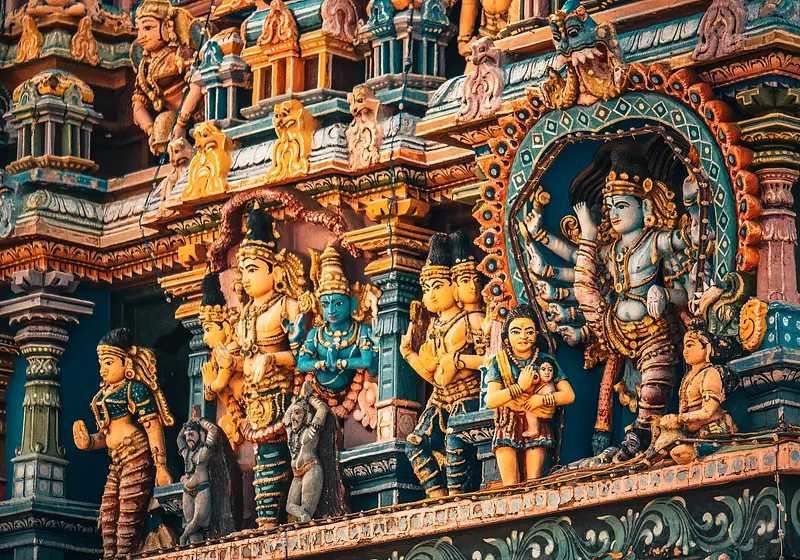When we read about the history of feminism, we unravel that the First-Wave Feminism happened in the 19th century. However, when we read the history of World Literature, in the The Epic of Gilgamesh (said to be written on tablet around 2150 BCE, which pre-dates Homer's Iliad and Odyssey by 1500 years), we see that when King Gilgamesh rejected the goddess Ishtar's sexual advances, she sends the Bull of Heaven to fight Gilgamesh. Gilgamesh and Enkidu slay the Bull of Heaven, which results in the gods condemning Enkidu to death.
Hence, making Gilgamesh afraid for life. Here we see how powerful a woman can be, how she defines herself, how she chooses the man she wants to have sexual relations with. Here, the goddess Ishtar is shown somewhat similar to a female version of Ravana. But if we look at Homer's Odyssey, we see that Odysseus was a womanizer.
Image Credit: Pulkit Agrawal
While his wife, who rejected all the other suitors, was waiting for him back home, he slept with another woman for eight years. We observe that around 566 BCE, women were shown as people who needed men to survive. In the 11th century novel The Tale of Genji by Murasaki Shikibu, we see that the text is male-dominated. Even though it is written by a woman who educated herself secretly while her brother was being taught by a tutor.
Coming to Chandrabati Ramayana as told to us by Nabaneeta Dev Sen, we see a woman living in the 15th century who is educated and heartbroken so that she decides to fight against patriarchy by retelling Ramayana from Sita's point of view. Valmiki’s Ramayana is said to be written around 500 BCE to 100 BCE. When we look at the timeline here, we see that patriarchy became prominent over time. We had authors like Murasaki Shikibu or Chandrabati who tried to raise their voices, but, as we know, Chandrabati Ramayana was a ‘silenced text’ rediscovered in the 1920s.
After reading Nabaneeta Dev Sen’s essay on Chandrabati Ramayana, we see how Sita dealt with the maleficent behaviour of men throughout the epic. Even though Valmiki’s Ramayana hints at the mistreatment, Chandrabati’s puts light on it. Calling it a Ramayana is misleading.
It should be called ‘Sitayana’- the journey of Sita’s life. We realise that throughout the text, men play a minimal role. Manly affairs, like battles or pride, are not mentioned.
Chandrabati does not talk about Rama’s valour, goodness, battle skills and wisdom. Rama, in her text, is shown as a lover who turns out to be a traitor who banished his pregnant wife partly because he was jealous. He is a bad husband, a bad king who listens to his evil sister, a bad brother who makes his younger brother act against his conscience and a bad father who was not there for most of his children’s childhood. Hence, Nabaneeta Dev Sen compares Rama to Shakespeare’s Othello, a jealous and over-possessive husband who murdered his innocent wife.
Image Credit: Transmedial Shakespeare
Instead, Chandrabati addresses a few crucial points, like Mandodari’s drinking poison as a reaction to being neglected by her husband, Ravana. But it does not kill her. Instead, she lays an egg, and inside the egg is Goddess Lakshmi.
When Ravana finds out, the only way for Mandodari to save the egg is to make Ravana throw the egg into the sea. A fisherman gets hold of the egg. Sata, his wife, a religious woman, performs some rituals to impress Goddess Lakshmi.
Sata then dreams of Goddess Lakshmi. She asks her to deliver the egg to King Janak’s wife. Sata did as told, and in return, she asked for the child to be named Sita, her namesake.
Chandrabati chose her characters wisely, and Nabaneeta Dev Sen does not fail to acknowledge that. She highlights the importance of women’s emotions in a male-dominated era. While Valmiki’s Ramayana focuses on Rama’s heroism and pride, Chandrabati's Ramayana focuses on Sita’s emotions, her ethical and moral fights and the importance of the roles of secondary characters like Madodari and Sata.
We realise that the role of these women in Sita’s life was crucial, even though she is unaware of their importance. Nabaneeta Dev Sen’s essay recognises the essence of Chandrabati’s Ramayana. Ravan's neglect of Mandodari and her reaction to the neglect portrays the importance of a secondary character’s emotions.
The women in the text condone men's actions because of the male dominance ideology. The intertextuality, and the borrowing of various mythologies like those of Krishna, Prahlad and Shakuntala encourage fresh perspectives on Ramayana to glorify ‘janamlila’ or Sita’s birth, as it was not given much significance in Valmiki’s Ramayana.
In the second book, Sita has a lot to say about her life, humiliation, abandonment and death or entry onto Mother Earth. Rama’s glories are barely mentioned, unlike in Valmiki’s Ramayana. The battle here is not the one that happened between Rama’s vanar sena and Ravana.
Instead, it is the one between Sita’s emotions and the patriarchal society. Chandrabati actively criticises the dominant male ideology but, at the same time, does not criticise Sita for acting per the very same dominant ideology.
Painting by BK Mitra
The questions that arise are: Did Sita deserve all this? Why did she keep up with the patriarchal ideology? Why did Chandrabati not criticise her about the same? Would Sita not have ‘entered Mother Earth’?
I share the same ideology as Chandrabati and Nabaneeta Dev Sen. Sita did not deserve the maltreatment. She deserved better.
She deserved to be respected, not because she was a woman, but because she respected the other person. Sita should not have kept up with the male-dominant ideology. However, women around her were subjected to maltreatment.
Hence, she expected the same for herself, so she dealt with all this and never complained. That might be the reason she was not criticised. Sita would not have ‘entered Mother Earth’, or in more colloquial language- killed herself, if she had received the love, benign treatment, and respect she deserved.
Since book three was written by a man after Chandrabati died, it lost its authenticity. In the third book, Lakshmana is the narrator, and it is evident that patriarchy found its way back in, and that ruins the point Chandrabati was trying to make. Sita should never have been a secondary character in the Ramayana.
Both Chandrabati and Nabaneeta Dev Sen expect the reader to recognise an obvious question: If it was not for Sita, would there have been a Ramayana? If it were not for women, would there be men?

















